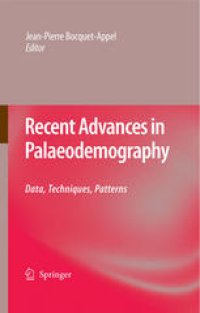
Ebook: Recent Advances in Palaeodemography: Data, Techniques, Patterns
- Tags: Archaeology, Demography, Anthropology, Social Sciences general
- Year: 2008
- Publisher: Springer Netherlands
- Edition: 1
- Language: English
- pdf
The written data used by demographers essentially cover the last five centuries. Since Homo Ergaster moved out of Africa around 1.8 million years ago and until the sub-contemporary periods, there is no data allowing us to reconstruct a demographic history that can be interpreted with the traditional tools of demography. If we want to be able to tackle demographic issues over a long evolutionary duration, trying to reconstitute our human demographic history and thinking out and testing macro-demographic theories, we need to draw on sources other than written data and on techniques other than those commonly used by demographers. This necessarily means using information of every kind, from archaeology, physical anthropology, paleontology, primatology or genetics, along with relevant models of interpretation.
This book has been developed from a core of papers selected for the paleodemographic session of the 25th World Population Congress (July 2005, Tours, France). It covers recent paleodemographic innovations, in terms of data, techniques and the detection of patterns making it possible to highlight hitherto unknown prehistoric demographic processes.
The written data used by demographers essentially cover the last five centuries. Since Homo Ergaster moved out of Africa around 1.8 million years ago and until the sub-contemporary periods, there is no data allowing us to reconstruct a demographic history that can be interpreted with the traditional tools of demography. If we want to be able to tackle demographic issues over a long evolutionary duration, trying to reconstitute our human demographic history and thinking out and testing macro-demographic theories, we need to draw on sources other than written data and on techniques other than those commonly used by demographers. This necessarily means using information of every kind, from archaeology, physical anthropology, paleontology, primatology or genetics, along with relevant models of interpretation.
This book has been developed from a core of papers selected for the paleodemographic session of the 25th World Population Congress (July 2005, Tours, France). It covers recent paleodemographic innovations, in terms of data, techniques and the detection of patterns making it possible to highlight hitherto unknown prehistoric demographic processes.